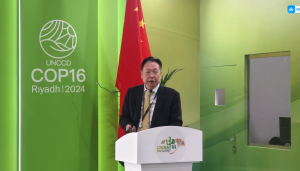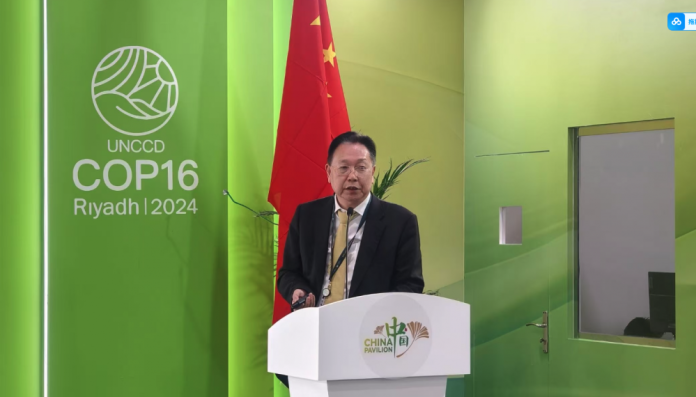[International Energy Network Live Report] On the afternoon of December 11th, the COP16 China Pavilion held a series of side events “From Arid Zones to Zero-Carbon Industrial Parks: Building Sustainable Energy Industry Systems” in Riyadh, Saudi Arabia. The conference was hosted by Center for Energy Transition and Social Development School of Social Sciences Tsinghua University, and co-hosted by China Renewable Energy Engineering Institute, China Arab Green Development Cooperation Center and International Energy Network.
Zhiyong Zeng, Dean of Zero-Carbon International Research Institute, China Zero-Carbon Clean Energy Co., Ltd, delivered a keynote speech on the topic of “Desert Control and Sustainable、Healthy、Safe Development of Agriculture”. He first introduced the local natural environment and energy development status of Saudi Arabia, then demonstrated China’s achievements in renewable energy, and finally demonstrated the actual cases of technologies and projects of the two countries in using photovoltaic and other renewable energy to control local deserts in Saudi Arabia.

Zhiyong Zeng, Dean of Zero-Carbon International Research Institute, China Zero-Carbon Clean Energy Co., Ltd
Saudi Arabia’s new energy market is full of potential
Zeng Zhiyong believes that Saudi Arabia is located at 20-30 north latitude, with an average of 2,200 kWh/m2 sunshine conditions, which is suitable for the development of photovoltaic solar energy industry. The Department of Energy is working out a plan to achieve the energy basic goal to reach at least 122.6GW in 2030.
To this end, the Saudi Ministry of Energy has formulated a renewable energy development planning target: by 2030, half of Saudi Arabia’s total installed capacity will be composed of new energy, with a scale of at least 140GW. The gap between the current status of Saudi Arabia’s local new energy development and the planning target makes Saudi Arabia’s new energy market full of potential.
Not only that, this also lays the foundation for the local desertification land governance work in Saudi Arabia. The reason, Zeng Zhiyong believes that this is determined by the local climate conditions and geographical environment. Because the western plateau of Saudi Arabia has a Mediterranean climate, the rest is a subtropical desert climate, there is the Great Nefud Desert in the north, and the Rub’ al Khali Desert in the south. If you want to achieve the goal of renewable energy development, you need to combine new energy development with desert governance.
China’s new energy industry has good strength
Zeng Zhiyong fully affirmed China’s strength in the development of new energy industry, and believes that this is also an important prerequisite for China and Saudi Arabia to reach cooperation in using the development of new energy industry to achieve desertification governance.
Zeng Zhiyong listed the development achievements of China’s new energy industry. He said frankly: “At present,China’s energy structure is diversifying.By the end of October 2024, the country’s cumulative installed power generation capacity was 3,194.27million KW, including 1,425.97million KW of thermal power, 430.88 million KW of hydropower, 58.08 million KW of nuclear power, 486.17 million KW of wind power, and 793.11 million KW of solar energy. Ultra-supercritical thermal power technology mainly used,and photovoltaic technology has entered the stage of perovskite industrialization,and Large-scale wind power generation, 20MW has been mass-produced, and CSP is included in the Energy Law,and Fourth-generation nuclear power technology is safer,and Energy storage technologies are in bloom. China’s new energy technology is moving to the forefront of the world and forming an important technology with global competitiveness.”
It is precisely because China has made many technological breakthroughs in the field of new energy that China has the opportunity to cooperate with Saudi Arabia in energy cooperation and desert control and achieve certain economic and social benefits.
China-Saudi Arabia cooperation in desert control is in action
Zeng Zhiyong then introduced the current progress of China and Saudi Arabia in desert control. He shared: “Tsinghua University has established Middle East Desert Control Research Institute in cooperation with Saudi University.The research carried out includes basic research of desert, new energy technology for desert control, desert soil and water improvement technology, desert new variety plant cultivation technology, desert sand application, etc.”
Zeng Zhiyong focused on the role of solar thermal technology in desertification control in Saudi Arabia. He believes that solar thermal technology can be similar to thermal power, hydropower, oil power, and gas power. It uses steam turbines to generate electricity and can quickly respond to power supply adjustments to ensure safe and stable operation of the power grid. At present, its cost is less than 60 cents per kilowatt-hour. With the expansion of scale, its cost may be reduced to less than 40 cents per kilowatt-hour in the future.
Not only that, the height of the solar thermal project reaches 3.5 meters, which is more conducive to the development of agriculture and animal husbandry and even animal husbandry below. In the future, through factory-scale production, its cost still has room for reduction.
Regarding the current situation of water shortage in the desert, Zeng Zhiyong believes that the application of heat pipe condensation water technology can alleviate the problem of water supply for crops on desertified land under photovoltaic panels. Zeng Zhiyong said that planting forage grass under wind power towers, photovoltaic panels, and solar thermal mirrors can form a microclimate, which is conducive to soil and water conservation. Carrying out cattle and sheep animal husbandry and developing and planting cash crop varieties in the desert power plant area can also achieve a win-win situation of economic growth and environmental governance.






